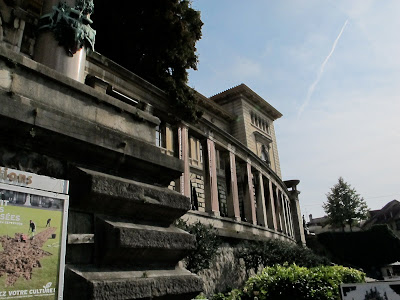The initial posting weeks ago about MI5 (btw, season 10 has begun!) and the formal nature of British acting inspired me to write about Bunraku, one of Japan's 3 classical theater forms, still active. Bunraku is puppet theater with orchestra and chanters who vocalize all roles stage right, while puppeteers manipulate the 3/4 lifesize dolls.

Striking are the high emotions these puppets create, as visceral experience links to language - script is authoritative

- and text animates wooden figures.

What you see is what you get, as the chanter sings all parts and visible puppet masters work the dolls; a theater parallel to interiors that make pipes and ductwork part of the design.
Bunraku accepts & visualizes brokenness, building a transparent theatre where the parts - actor, story, prop, stage, musicians, viewer - are woven into a multifaceted, yet textual, unity.
By contrast, the conventions of mainstream Hollywood film being humanistic, musical and verbal cues advance plots & characters in an unfolding, linear arc, requiring passivity, distance, & fragmentation in the viewer whose main role is to identify, emote, go along.
"The function of..Western theatre of the last few centuries has been..to show what is said to be secret ("feelings,""situations,""conflicts"), while hiding the very artifice of the show (stage effects, painting, powder, light sources)...The Western spectacle is anthropomorphic...the Western actor...the voice..the look..the figure are eroticized...like so many fetishes.
Bunraku exposes the sources of theatre in their emptiness. What..replaces [theater] is the action necessary to the production of the spectacle. Work substitutes for interiority...Emotion no longer inundates, no longer submerges, it becomes reading material."
Roland Barthes, "On Bunraku"
***
Liturgical worship operates similarly; eg All Saints follows a prayer book (essentially, an updated script based upon the Book of Common Prayer),

where the minister reads plain type, the congregation responds the bold:
The Lord is here.
His Spirit is with us.
Lift up your hearts.
We lift them to the Lord.
Let us give thanks
to the Lord our God.
It is right to give thanks and praise.
***
We break this bread
to share in the body of Christ.
Though we are many, we are one body,
because we all share in one bread.
Perhaps we are the lifeless puppets, animated chanters, & visible stage hands, bringing to life the Church Invisible, meeting Christ at the table -
"..if the Spirit of him who raised Jesus from the dead is living in you, he who raised Christ from the dead will also give life to your mortal bodies because of his Spirit who lives in you." Romans 8:11
- a Eucharistic Bunraku, if you will.
***
Western theater largely stems from the Mass, although I went to Japan for the premodern precedent. And while imagining the world as a stage is not novel (!), bunraku's attributes uniquely merges the textual and theatrical.
***
FYI, Barthes was a pioneer semiotician & highly influential literary critic. Although there is a long history of Euro-American intellectuals, usually French, who completely misread Asia - brilliant at home, utterly stupid abroad - Barthes, was generally reliable.

Japan has been an aesthetic obsession dating to the 1870s, when Monet, Van Gogh, Degas, Eisenstein, Frank L.Wright, Pound, etc interpreted Japanese culture as an artistic antidote to Western rationalism, propelling its inventive arts & design practices into global currency most recently explored by the anime and the video gaming community.
(
Image, Music, Text is a classic - the chapter where he analyzes an Italian spaghetti ad, pioneer in its day.)


























































